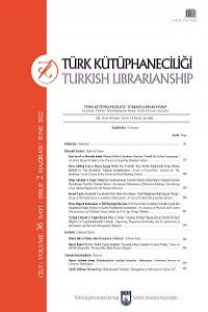Bilgi Erişim Sürecinin Problem Çözme ve Karar Verme Üzerindeki Etkisi: Kuramsal Bir Çalışma
bilgi gereksinimi, bilgi erişim sistemleri, bilgi erişim süreci, karar verme, problem çözme
Effects of Information Retrieval Process on Decision Making and Problem Solving:An Emprical Study
information need, information retrieval systems, information retieval process, decision making, problem solving,
___
- Al-Maskari, A., ve Sanderson, M. (2010). A review of factors influencing user satisfaction in information retrieval. Journal of the American Society for Information Science and Technology, 61(5), 859-868. doi: 10.1002/ asi.21300
- Burke,P. (2008). Bilginin Toplumsal Tarihi. M. Tunçay (Çev.), İstanbul: Tarih Vakfı Yurt Yayınları.
- Burnkrant, R.E. (1976). A motivational model of information processing intensity. Journal ofConsumer Research, 3(1), 21-30. http://www.jstor.org/stable/ 2489092 adresinden erişilmiştir.
- Case, D. O. (2002). Looking for Information: A survey of Research on Information Seeking, Needs and Behavior. California: Academic Press.
- Campello,B., ve Abreu, V. L. F. G. (2005). Information literacy and the education ofschool librarians. School Libraries Worldwide, 11(1). 37-52.
- Choo, C. W., Bergeron, P., Detior, B., ve Heaton, L. (2008). Information culture and information use: An exploratory study of three organizations. Journalof the AmericanSociety for Information Science and Technology, 59(5): 792-804. 23 Mayıs 2011 tarihinde http://ehis.ebscohost.com/eds/ pdfviewer/pdfviewer?vid=3&hid=2&sid=1b343 060-97f6- 4167-8b04- c807e36ea2f7%40sessionmgr14 adresinden erişilmiştir.
- Daft, R. L. (1991). Management. Chicago: Dryden Press.
- Dervin, B., ve Nilan, M. (1986). Information needs and uses. In M. E. Williams (Ed.),Annual Review of Information Science and Technology içinde (ss. 3-33). Medford, NJ: Information Today.
- Dictionary of Information & Library Management. (2006). London: A & C Black.
- Doyle,C. S. (1994). Information Literacy in an Information Society: A Concept for the Information Age. Syracuse, New York: ERIC Clearinghouse on Information& Technology. 23 Mayıs 2011 tarihinde http://www.eric.ed.gov/ ERICDocs/data/ericdocs2sql/content_storage_01/0000019b/80/25/55/95. pdf adresinden erişilmiştir.
- Eisenberg,M. B. (2008). Information literacy: Essential skills for the information age. DESIDOC Journal of Library & Information Technology, 28(2), 39-47. 23 Mayıs 2011 tarihinde http://ehis.ebscohost.com/eds/ pdfviewer/pdfviewer?vid=3&hid=2&sid=929638 44-59ed-48f3-8379 e7488807%40sessionmgr15 adresinden erişilmiştir.
- Fainburg, L. I. (2009). Information seeking and learning: A comparison of Kuhlthau'sinformation seeking model and John Dewey's problem solving model. New Library World, 110 (9), 457-466.
- Feather, J. (2008). The Information Society a Study of Continuity and Change. London:FacetPublishing.
- Griffiths, J. M. (2003). Information Retrieval. Encyclopedia of Distributed Learning. 23 Mayıs 2011 tarihinde http://www.sage-ereference.com/ distributedlearning/Article _n82.html adresinden erişilmiştir.
- Gurvitch, G. (1984). Sosyoloji ve Felsefe. K. Cangızbay (Der.), İstanbul: Değişim Yayınları.
- Gürdal, O. (2000). Yaşamboyu öğrenme etkinliği “enformasyon okuryazarlığı”. Türk Kütüphaneciliği, 14(2), 176-187.
- Gürdal T., O. (2009). Enformasyon zincirinde bilgi erişim sistemleri, bilgi erişim sürecinde kütüphane kurumu ve diğer bilgi merkezleri. Türk Kütüphaneciliği, 23(1), 151-168.
- Havelock, R. G. (1975). Research on the utilization of knowledge. In M. Kochen (Ed.),Information for Action: From Knowledge to Wisdom içinde (ss. 87 107). New York: Academic Press.
- International Encyclopedia of Information and Library Science. (2003). J. Feather & P. Sturges (Eds.), London: Routledge.
- Keseroğlu, H. S. (2010). Bilginin bilgisi: Kütüphane ve bilgibilim kuramı sorunsalı.Türk Kütüphaneciliği, 24(4), 685-704.
- Kneeland, S. (2001). Problem Çözme. N. Kalaycı (Çev.), Ankara: Gazi Kitabevi.
- Kuhlthau, C. C. (1996). Seeking Meaning: A Process Approach to Library and Information Services. Norwood, NJ: Ablex.
- Kurbanoğlu, S. S., ve Akkoyunlu, B. (2002). Bilgi okuryazarlığı: Bir ilköğretim okulunda yürütülen uygulama çalışması. Türk Kütüphaneciliği, 16(1), 20 40.
- Lancaster, F. W. (1968). Information Retrieval Systems: Characteristics, Testing, and Evaluation. New York: Wiley.
- Luenberger, D. G. (2006). Information Science. Princeton: Princeton University Press.
- Mabawonku, I. (2006). The information environment of women in Nigeria's public service. Journal of Documentation, 62(1), 73-90. 23 Mayıs 2011 tarihinde http://www.emeraldinsight.com/journals.htm?issn=0022-0418& volume=62&issue=1adresindenerişilmiştir.
- Miller, G. A., Galanter, E., ve Pribham, K. H. (1960). Plans and the Structure of Behavior. New York: Holt.
- Moore, N. (2002). A model of social information. Journal of Information Science, 28(4), 297-303. doi: 10.1177/16555150202800404
- Nagy, M. (2004). Information Retrieval System. Encyclopedia of Public Relations. http://www.sage-ereference.com/publicrelations/Article_n216. html adresinden erişilmiştir.
- Nielsen, B. G.,veBorlund, P. (2011). Information literacy, learning, and the public library:A study of Danish high school students. Journal of Librarianship and Information Science, 43(2), 106-119.
- O'Connor, J. (1968). Some questions concerning “information need”. American Documentation, 19(2), 200-203.
- Polya, G. (1997). NasılÇözmeli? Matematikte Yeni Bir Boyut. F. Halatçı (Çev.), İstanbul: Sistem Yayıncılık.
- Reitz, J. M. (2004). Dictionary for Library and Information Science. USA: Libraries Unilimited.
- Robinson-Riegler G. ve Robinson-Riegler B. (2008). Cognitive Psychology: Applying the Science of Mind. Boston: Pearson Education.
- Saracevic, T. (1999). Information science. Journal of the American Society for Information Science, 50 (12), 1051-1063.
- Toffler, A. (1975). Gelecek Korkusu: Şok. S. Sargut (Çev.), Altın Kitaplar Yayınevi.
- Uçak, N. Ö., (2010). Bilgi: Çok yüzlü bir kavram. Türk Kütüphaneciliği, 24(4), 705-722.
- Uçak, N. Ö., (1997). Bilgi gereksinimi ve bilgi arama davranışı. Türk Kütüphaneciliği, 11(4), 315-325).
- Van Rijsbergen, C. J. (1979). Information Retrieval.2nd.ed. London; Boston: Butterwoths.
- Wilson, T. D., (1981). On user studies and information needs. Journal of Librarianship, 37(1), 3-15.
- Yayın Aralığı: 4
- Başlangıç: 1952
- Yayıncı: Türk Kütüphaneciler Derneği
Minho Üniversitesi Açık Erişim Deneyimi: OpenAIRE, OpenAIREplus, MedOANet
Avrupa Bilimetri Yaz Okulundan İzlenimler
E-öğrenmenin Gelişimi ve İnternetin Eğitim Sürecine Yansımaları: Gazi Üniversitesi Örneği
Mehmet TOPLU, Şahin GÖKÇEARSLAN
Popüler Kültürde Kadın Kütüphanecilerin İmajı: Feminist Bir Yaklaşım
Bilgi Erişim Sürecinin Problem Çözme ve Karar Verme Üzerindeki Etkisi: Kuramsal Bir Çalışma
Kamu Kurumlarında Dijital Medya İletişimi
